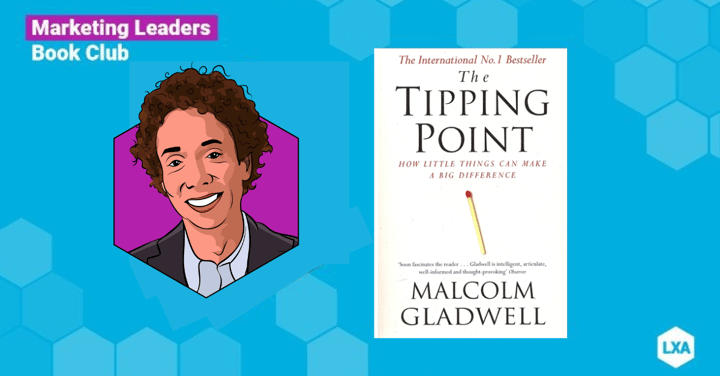
We're bringing you the best insights written in the world of marketing today, thanks to our sponsors at Adobe
“The tipping point is that magic moment when an idea, trend, or social behaviour crosses a threshold, tips, and spreads like wildfire," says Malcolm Gladwell, on his concept of the 'Tipping Point'.

This idea explains how ideas spread like epidemics and details the elements which need to come together to help these ideas reach a point of ultimate critical mass, where their viral effect becomes unstoppable.
The Tipping Point: How Little Things Can Make a Big Difference is the debut book by Malcolm Gladwell, first published in 2000. Let's jump in.
Why Tipping Point is Vital for Any Modern Marketer
Malcolm Gladwell describes the "three rules of epidemics" in his work. These are also known as the three "agents of change", which sounds like a 70s spy film. Let's have a look at these three rules.
- The Law of the Few. This is, as the author states, "The success of any kind of social epidemic is heavily dependent on the involvement of people with a particular and rare set of social gifts." Economists call this the "80/20 Principle, which is the idea that in any situation roughly 80 per cent of the 'work' will be done by 20 per cent of the participants".
- The Stickiness Factor. This refers to the specific content of a message which renders it memorable. This might include a TV show, movie franchise, or brand. Malcolm gives the example of Sesame Street and Blue's Clues, which pioneered the properties of the stickiness factor, thus enhancing effective retention of educational content as well as entertainment value. Gladwell states, "Kids don't watch when they are stimulated and look away when they are bored. They watch when they understand and look away when they are confused".
- The Power of Context. Human behaviour is sensitive to its environment. Gladwell explains: "Epidemics are sensitive to the conditions and circumstances of the times and places in which they occur."
For example, "zero tolerance" efforts to combat minor crimes such as fare-beating and vandalism of the New York subway led to a decline in more violent crimes citywide.
Gladwell describes the bystander effect and explains how Dunbar's number plays into the tipping point, using Rebecca Wells' novel Divine Secrets of the Ya-Ya Sisterhood, evangelist John Wesley, and the high-tech firm W. L. Gore and Associates. Dunbar's number is the maximum number of individuals in a society or group whom someone can have real social relationships with, which Gladwell dubs the "rule of 150."
About the Author
Malcolm Gladwell is a Canadian author of five bestsellers, The Tipping Point, Blink, Outliers, What the Dog Saw, and David and Goliath.
He was, and continues to be, a staff writer at The New Yorker in 1996, and gained popularity with two articles in the publication that year, ‘The Tipping Point’ and ‘The Coolhunt.’ These two articles formed the basis for The Tipping Point.
Malcolm is the co-founder of Pushkin Industries, an audio content company that produces Malcolm’s podcasts Revisionist History and Broken Record. Gladwell has been included in the Time 100 Most Influential People list and was appointed to the Order of Canada on 30th June 2011.
Top Takeaways
“Emotion is contagious.”
- Malcolm Gladwell, The Tipping Point: How Little Things Can Make a Big Difference
Marketers should aim to consider three lessons from the book, which will help them spread their own ideas in a similar way.
So, it might be good to note that when an idea reaches the tipping point, it spreads like fire. They should also consider that there are three kinds of people who are responsible for getting ideas to tip in this way:
- Connectors, who have a huge social following and network
- Salesmen, who support and boast about the ideas they love
- Mavens, who hoard info in order to be a great source of tips to their network.
The final consideration is the idea of stickiness; without stickiness, no idea will ever tip.
Malcolm gives the example of Instagram. They had a lot of growth early on – but it was still steady growth. There was a definite moment though, in February 2012, when all of a sudden, the entire world seemed to need an account.
It’s in this exact moment that Instagram’s user growth curve shoots up meteorically and it becomes the fastest growing social network of all time.
“If you want to bring a fundamental change in people's belief and behaviour...you need to create a community around them, where those new beliefs can be practised and expressed and nurtured.”
― Malcolm Gladwell, The Tipping Point: How Little Things Can Make a Big Difference
Link to purchase page
Purchase Precision Demand Marketing on Amazon and Audible
Other Books You May Be Interested In
- Hacking Growth by Sean Ellis and Morgan Brown
- Marketing 5.0 by Philip Kotler
- Digital Darwinism 2nd Edition by Tom Goodwin
We're bringing you the best insights written in the world of marketing today, thanks to our sponsors at Adobe

Stay tuned for more! 📖📚
